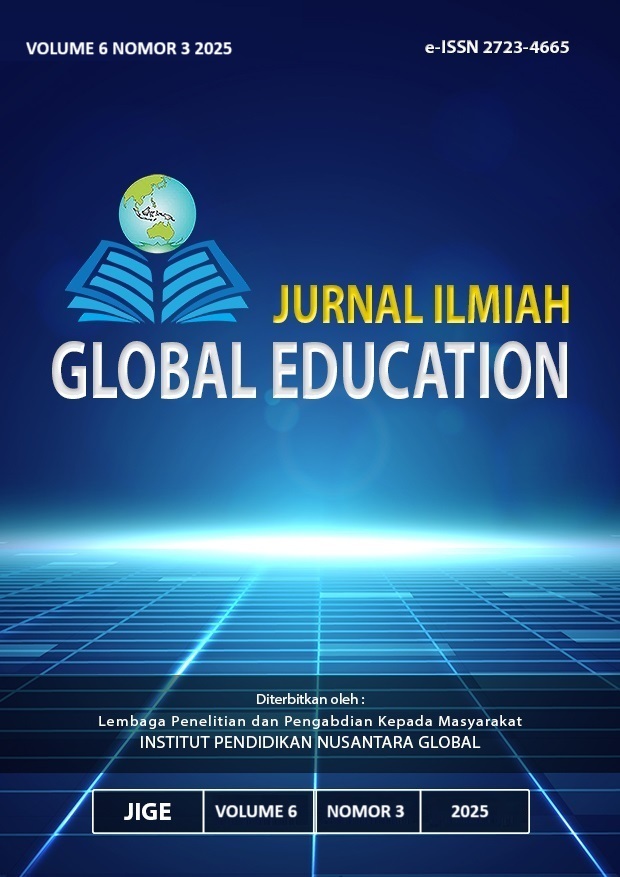Strengthening Indonesia's Defense Industry through Strategic Insights from Japan’s Defense Systems
DOI:
https://doi.org/10.55681/jige.v6i3.4194Keywords:
defense industry, Self-Reliance, Technology Transfer, CollaborationAbstract
Indonesia's defense industry faces significant challenges in achieving self-reliance, including a heavy dependence on imported military technology, which limits its strategic autonomy and industrial competitiveness. This research analyzes how Indonesia can strengthen its defense industry by leveraging strategic insights from Japan’s defense systems. This country has successfully built an advanced defense industry despite constitutional constraints. The study employs a qualitative method, focusing on literature review and secondary data from various sources. The findings suggest that Japan’s collaboration model, which involves the government, private sector, and academia, can be adopted in Indonesia. Technology transfer strategies and dual-use technologies can foster innovation and reduce import reliance. The implications of this research highlight the importance of increasing investment in research and development (R&D) and expanding international cooperation to enhance Indonesia’s defense industry self-reliance.
Downloads
References
Achmadi, B., Zauhar, S., Sh, B., & Fefta, A. (2019). The Implementation of the Defense Industrial Base (DIB) a Comparative Study of Indonesia and Brazil. 22(2).
Cai, Y., & Etzkowitz, H. (2020). Theorizing the Triple Helix model: Past, present, and future. In Triple Helix (Vol. 7, Issues 2–3, pp. 189–226). Brill Academic Publishers. https://doi.org/10.1163/21971927-bja10003
Czulda, R. (2020). Defence industry in Iran–between needs and real capabilities. Defense and Security Analysis, 36(2), 201–217. https://doi.org/10.1080/14751798.2020.1750184
Djansena, A. (2021). Peningkatan Peran Industri Pertahanan Indonesia (Studi Kasus Kerjasama MOD Jepang dengan Industrinya) (Vol. 5, Issue 1).
Foltýnek, T., Dlabolová, D., Anohina-Naumeca, A., Razı, S., Kravjar, J., Kamzola, L., Guerrero-Dib, J., Çelik, Ö., & Weber-Wulff, D. (2020). Testing of support tools for plagiarism detection. International Journal of Educational Technology in Higher Education, 17(1). https://doi.org/10.1186/s41239-020-00192-4
Gachie, W. (2020). Higher education institutions, private sector and government collaboration for innovation within the framework of the Triple Helix Model. African Journal of Science, Technology, Innovation and Development, 12(2), 203–215. https://doi.org/10.1080/20421338.2019.1631120
Govella, K. (2021). The Adaptation of Japanese Economic Statecraft: Trade, Aid, and Technology. World Trade Review, 20(2), 186–202. https://doi.org/10.1017/S1474745620000543
Hao Wang Natalie Zimmermann, P. (2021). Collegiate Aviation Review International Maintenance of Composite-Based Aircraft Components and Structures through the Perspective of Aviation Maintenance Technicians in the United States. http://ojs.library.okstate.edu/osu/index.php/CARI/article/view/8305/7648
Haryanto, H. I., Hidayat, T., Bainus, A., & Sudirman, A. (2022). Supporting Industrial Cooperation in Independence of PT. Dirgantara Indonesia and Its Contribution to Indonesian Air Power. In SPECIALUSIS UGDYMAS / SPECIAL EDUCATION (Vol. 2022, Issue 43).
Irfan, M., Nidar, S. R., Azis, Y., & Widianto, S. (2023). Self-reliant in defense industries: Case study Indonesia. Cogent Business and Management, 10(3). https://doi.org/10.1080/23311975.2023.2262715
Irfan, M., Rahman, S., Azis, Y., & Widianto, S. (2023). Defense industry business performance model in developing countries. Problems and Perspectives in Management, 21(2), 172–186. https://doi.org/10.21511/ppm.21(2).2023.20
Japan MOD. (2023). Defense of Japan. MinistryOfDefense.
Lee, C., Lee, D., & Shon, M. (2020). Effect of efficient triple-helix collaboration on organizations based on their stage of growth. Journal of Engineering and Technology Management - JET-M, 58. https://doi.org/10.1016/j.jengtecman.2020.101604
Matsuda, T. (2020). Explaining Japan’s post-Cold War security policy trajectory: maritime realism. Australian Journal of International Affairs, 74(6), 687–703. https://doi.org/10.1080/10357718.2020.1782346
Nam, S., Choi, S., Edell, G., De, A., & Song, W. K. (2023). Comparative Analysis of the Aviation Maintenance, Repair, and Overhaul (MRO) Industry in Northeast Asian Countries: A Suggestion for the Development of Korea’s MRO Industry. Sustainability (Switzerland) , 15(2). https://doi.org/10.3390/su15021159
Noya, S., Taneo, S. Y. M., & Melany. (2023). Triple Helix Innovation Ecosystem: The Role of Small and Medium Enterprises Community in Enhancing Performance. Quality Innovation Prosperity, 27(1), 46–61. https://doi.org/10.12776/QIP.V27I1.1759
Nugroho, S. S. (2022). Utilization of the Defense Industry in Supporting the Duties of the Navy to Enforce the Law and Maintain Security in Indonesian Waters. Journal of Industrial Engineering & Management Research, 3(6). https://doi.org/10.7777/jiemar
Otani, Y., & Kohtake, N. (2019). Applicability of Civil and Defense Dual Use to Space Situational Awareness System in Japan. Space Policy, 47, 140–147. https://doi.org/10.1016/j.spacepol.2018.11.001
Reis, J., Melão, N., Costa, J., & Pernica, B. (2022). Defence industries and open innovation: ways to increase military capabilities of the Portuguese ground forces. Defence Studies, 22(3), 354–377. https://doi.org/10.1080/14702436.2022.2033117
Richardson, L. (2020). The Autonomy‒Alignment Trade-Off: Japan’s Evolving Defense Posture. Asian Politics and Policy, 12(1), 27–39. https://doi.org/10.1111/aspp.12510
Rojas-Sánchez, M. A., Palos-Sánchez, P. R., & Folgado-Fernández, J. A. (2023). Systematic literature review and bibliometric analysis on virtual reality and education. Education and Information Technologies, 28(1), 155–192. https://doi.org/10.1007/s10639-022-11167-5
Sahashi, R. (2020). Japan’s strategy amid US–China confrontation. China International Strategy Review, 2(2), 232–245. https://doi.org/10.1007/s42533-020-00061-9
Sakaki, A., & Maslow, S. (2020). Japan’s new arms export policies: strategic aspirations and domestic constraints. Australian Journal of International Affairs, 649–669. https://doi.org/10.1080/10357718.2020.1781789
Sarjito, A., & Sutawidjaya, A. H. (2024). Indonesia’s National Defense Resilience During Covid-19: Key Lessons. Journal of Ecohumanism, 3(4), 2913–2926. https://doi.org/10.62754/joe.v3i4.3806
Sjamsoeddin, S., Yusgiantoro, P., Saragih, H. J. R., & Soepandji, B. S. (2023). Transformational Bureaucratic Leadership Model to Support National Defense Policy in Indonesia. Jurnal Ilmu Sosial Dan Ilmu Politik, 26(3), 227–239. https://doi.org/10.22146/jsp.70204
Surahman, Nengah Putra, I., & Asvial, M. (2024). Independence of the Indonesian Defense Industry and Challenges in Defense Budget Allocation. International Journal Of Humanities Education And Social Sciences (IJHESS), 3(4). https://ijhess.com/index.php/ijhess/
Wahyuni, S., Onodera, K., & Wahyuningsih. (2019). Collaboration for Innovation: An Evidence from Tokyo. South Asian Journal of Business and Management Cases, 8(2), 182–194. https://doi.org/10.1177/2277977919833772
Downloads
Published
How to Cite
Issue
Section
License
Copyright (c) 2025 Alradix Djansena, Katherine Erika, Robbi Adhilni, Tomy Ronaldi, Yuli Kartiningsih, Ghazalie

This work is licensed under a Creative Commons Attribution-ShareAlike 4.0 International License.












